Bryanna Clark Grogan’s Vegan Feast Kitchen/ 21st Century Table: The kitchen journal of a vegan food writer.. I'm on Facebook and Twitter (see links in sidebar at right).
Thursday, April 27, 2006
VEGAN CAPPUCCINO-- WHICH NON-DAIRY MILK FOAMS THE BEST?


Blue-striped cup, rear left: homemade soymilk; white cup, rear right: Almond Breeze; front in blue cup: Soy Dream
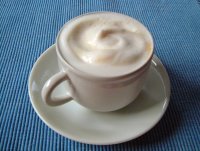
UPDATE: Ap. 28th, 8:50 am....cappuccino with Vitasoy Original.
PS: FOR NOTES ABOUT HOW TO KEEP SOYMILK FROM CURDLING IN COFFEE, LOW-ACID COFFEE, CHOOSING COFFEE, STOVETOP ESPRESSO MAKERS, ETC., SEE THE BLOGGER COMMENTS FOR THIS ENTRY.
COMPARING NON-DAIRY MILKS FOR THE BEST CAPPUCCINO FOAM
I'm not a regular coffee-drinker, but I do like a good cappuccino (made with organic, fair-trade dark roasted beans) now and then. We went shopping yesterday and I had a soy cappuccino at a local coffeehouse. The foam was pathetic! They used Silk and a professional foamer, but I might as well have had a latte. Now, as it happens, just the day before, I had pulled our cheap plunger-type milk foamer:

out of the cupboard and made myself a beautifully-foamed cappuccino using my homemade soymilk.
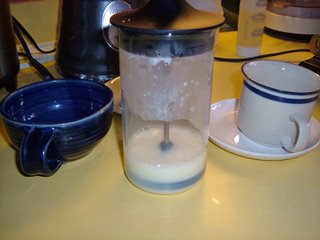
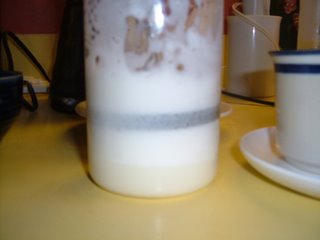
My husband (an expert) was very impressed! The foam really lasted, too.
Today I wanted to compare some vegan milks, so I made three cappuccinos-- one with my freshly homemade soymilk, one with Soy Dream (Original), and one with Almond Breeze (Original). (From past experience, I know that rice milk doesn't foam well, so I chose good-tasting Almond Breeze for the non-soy option..it's quite low in fat, too.)
The homemade soymilk won hands-down again! A beautiful stiff, long-lasting foam with only 30 seconds in the hand-plunger! The Soy Dream came in second, and the Almond Breeze third-- though it had a much better foam than the Silk used in the coffeehouse. UPDATE, morning of April 28th: I tried a cappuccino with Vitasoy Original this morning (see photo above) and it was very nice-- similar to soy Dream, so I'd say they tie for second place.
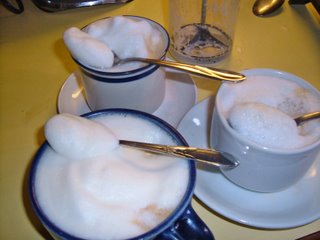
Blue-striped cup, rear left: homemade soymilk; white cup, rear right: Almond Breeze; front in blue cup: Soy Dream
Cheers!

Tuesday, April 25, 2006
QUICKIE MEAL

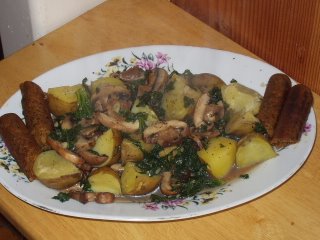
HEAR MY INTERVIEW ON GO VEGAN TEXAS! RADIO, ALONG WITH KAREN DAVIS OF UNITED POULTRY CONCERNS-- go to this link to access the archived interview.
Lately, I've been rushing upstairs from my office to the kitchen around 5 PM to find something to make for dinner. Usually I plan ahead, at least in the morning, but I've been on a deadline. This is a favorite quickie meal:
POTATOES AND BRAISED KALE WITH MUSHROOMS AND ITALIAN VEGGIE SAUSAGES
This is just a guide--you don't need a recipe for this.
Clean and trim and slice a whole pile of kale-- it will cook down alot.
Steam, boil or microwave some thin-skinned potatoes, cut into chunks. I microwave them in a microwave steamer.
In a large deep skillet, saute as much chopped garlic as you want in a little olive oil-- gently-- don't brown it! I would use maybe 4 cloves for the two of us. Add some sliced mushrooms-- as much as you want-- and brown them a bit. Add the kale and about a cup of vegetarian broth. Bring to a boil and then turn it down to medium and cover it. While this cooks (check it to see if you need more broth-- you want it to cook down, but still be a bit brothy to moisten the potatoes), brown as many Tofurkey Italian Sausages as you like, in a grill or in a skillet with a little olive and/or Asian (toasted) sesame oil.
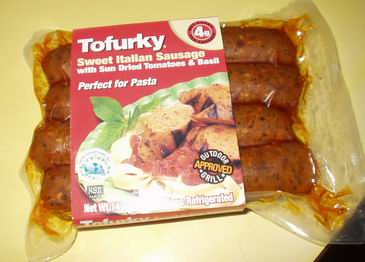
These vegan sausages are really good, but they are big and kind of high in fat. A big eater or a very hungry person can eat a whole one; daintier or less hungry diners may only want half of one.
When the kale is tender (I cook it maybe 10 minutes) and the potatoes are done, drain the potatoes and add them to the kale, stirring gently to mix the ingredients. Add a bit more broth if necessary. Add salt and pepper to taste (you could add a bit of red pepper flakes, if you like things spicy) and serve with the browned veggie sausages.
Enjoy!

Sunday, April 23, 2006
VEGAN POTATO AND SWEET POTATO GRATIN

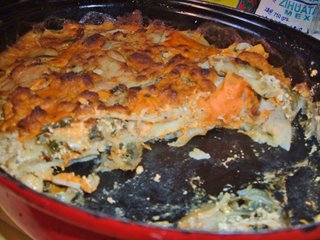
My mom came over for lunch today and I was looking for a light entree to make. I had 1/2 a raw sweet potato left, and 1/2 a block of my homemade vegan "cheddar" in the freezer, so I decided to mix the sweet potato with white potato and make a vegan gratin. It was delicious! My "cheddar" is tahini
Printable Recipe
BRYANNA'S POTATO AND SWEET POTATO GRATIN WITH SAGE
Updated April 2011
Servings: 4 ( actually, 3 of us ate the whole thing!)
1 large onion, thinly-sliced
1-2 Tbs chopped fresh sage
2 tsp olive oil
8 oz. sweet potato, peeled and sliced very thinly
1 lb thin-skinned white potatoes, scrubbed and sliced very thinly
1/2 cup chopped parsley
1 large clove garlic, minced
about 2 cups (grated and not packed down) of your favorite vegan "cheese" that melts well
salt and freshly-ground pepper to taste
1 cup soy or nut milk, warmed
Preheat the oven to 350°F. Lightly oil a 2 qt. gratin dish
Heat the oil in a nonstick heavy skillet and add the onions and sage. Cook over medium heat, stirring often, until they soften and turn golden. OR, place the oil in a microwave-safe dish or casserole
I use a mandoline slicer to cut the potatoes very thinly. I have one similar to this one
Drain the potatoes and mix in a large bowl
Grate the "cheese". (The photos are of my Vegan "Cheddar" from my old Vegan Feast newsletter, which grates best when frozen or semi-frozen-- a related recipe for Vegan "Gruyere" is in my new book
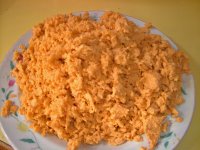
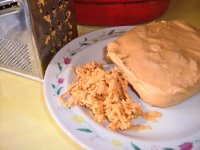
Spread 1/3 of the potatoes in the prepared pan. Sprinkle with salt and pepper and 1/3 of the "cheese". Repeat layering two more times. Pour the warm soy or nut milk over the gratin.

Cover with foil. Bake 25 minutes. Remove foil and bake 25 minutes more. Let the gratin stand for 5 minutes before serving.
Nutrition Facts
Nutrition (per 1/4 of the casserole): 209.2 calories; 20% calories from fat; 4.9g total fat; 0.0mg cholesterol; 137.0mg sodium; 857.5mg potassium; 36.8g carbohydrates; 6.0g fiber; 6.7g sugar; 30.8g net carbs; 6.1g protein; 3.8 points.

Enjoy!

Tuesday, April 18, 2006
THE 1906 EARTHQUAKE IN SAN FRANCISCO, MY GRANDFATHER, & SOURDOUGH

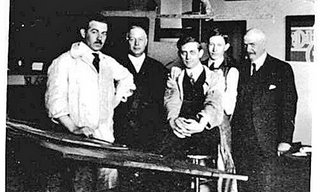
My grandfather, Gilbert Tonge (on the left), with his silkscreen art printing company colleagues in San Francisco in 1916.
SCROLL DOWN FOR A LIST OF LINKS TO SOURDOUGH RECIPES ON THIS BLOG.
Today is the centennial of the Great 1906 San Francisco Earthquake. That's where I'm from, originally, and my maternal grandfather, Gilbert Tonge, survived the disaster (he was a 22-year-old art student at the time). He used to tell us about it and I wish I had recorded some of that! But, of course, we were young, and didn't realize the historical importance of his stories. He was born in California, in what is now Placerville, in El Dorado County. The town was called "Hangtown" at one time!
 |
Cooking in the street after the 1906 San Francisco earthquake:
Above is a photo of my grandfather, Gilbert Ross Tonge (age 22 at the time, on the far left-- my cousin Chris Tonge looks just like him!); Guillermo DeCastro next to him; then my great-grandmother, Mary Hicks Tonge; then someone named Amelia; and, on the far right, my grandfather's Aunt Libby (Elizabeth Tonge Barret).
This photo was sent to one of my cousins by a Swiss art historian, Guido Lengwiler, who wrote a fascinating book on the history of screen printing. The book includes a section about my grandfather, who helped develop a type of silk-screening. (See http://www.signindustry.com/screen/articles/2014-04-01-History-of-screen-printing-part-2.php3) |
My mother was also born in California. Not to be outdone by her father, my mother was visiting California in 1989 when the Loma Prieta earthquake hit. In fact, she was in Santa Cruz, near the epicenter, and she and a friend [both senior citizens] had to run from a store, with goods from the shelves falling on their heads!
Anyway, all this got me thinking about San Francisco food memories. What came to mind first and foremost was sourdough. The sourdough bread was so delicious! I hope it still is-- I haven't visited for some time. You can't always get good sourdough bread up here very easily, so I make it myself. Of course, I really need an outdoor oven to get a good crust on it, and we may try making one this summer! UPDATE: Try the "bake in a pre-heated heavy pot or casserole" method for a super crust in your stove's oven.
**I also use the "Oregon Trail Sourdough Starter", which I treat the same way. You can get a free (dried) starter (and it's a great story that goes with it!) here. You just pay postage. (PS: I don't use the sugar and potato they call for in the instructions., and it works fine.)**
To acknowledge the centennial, I'm posting the vegan yogurt-based starter recipe.
UPDATE: More sourdough recipes on this blog:
Golden Sourdough Rolled Biscuits
Dutch Pumpernickel Bread
No-Knead Sourdough Bread Experiment
Crusty No-Knead Half-Whole Wheat Sourdough Bread (free-form or pan loaf)
Vegan Whole Grain Sourdough Pancakes
More Ways to use Sourdough Pancake batter-- sourdough, vegan, whole grain waffles and crepes!
BRYANNA'S VEGAN YOGURT SOURDOUGH STARTER
Printable Copy of recipe and Information
I keep sourdough starters in my fridge at all times. They will stay “fresh” (that is, active enough to use straight from the fridge in a bread recipe) for about two weeks. If you haven’t used your starter and refreshed it within two weeks, then dump out some of it and refresh it (preferably once a week). I keep a white starter, and one whole wheat and one rye.
In my opinion, most bread machine breads just don’t come up to scratch compared to our oven-baked breads. There is something missing. I have discovered that if you use the old-fashioned sponge method (the liquid and half the flour with the yeast—often much less than usual-- risen for 2 to 12 hours), or an Italian biga starter, or French poolish, etc., OR the use of sourdough gives better flavor, texture and keeping qualities (and you can also get away with a more moist dough, which I think makes better bread). If I use sourdough straight from the fridge with hot liquid and a little yeast (only 1.2-1 tsp.), I can make a bread without starting it hours before (although that is no problem—just put on the sponge before going to bed at night). I have converted lots of breads this way. If you use some yeast and sweetener, the sourdough flavor is not pronounced. To convert, use 1 c. starter in place of 2/3 to 3/4 c. liquid and 1/3 c. flour (approximately).
I generally use Canadian unbleached flour, which is similar to American unbleached bread flour, and wholewheat flour made from hard wheat (grind my own), and have not found it necessary to use gluten flour (even in all wholewheat bread).
HERE’S HOW I MAKE MY OWN STARTER:
I learned how to make San Francisco-style sourdough starter from Sunset magazine years ago. They had scientists from the University of California look at San Francisco starter and found that the closest thing to that particular sourdough bacteria was yogurt. I made it for many years with dairy yogurt and loved it. When I became a vegan, I tried it with soy milk, and it worked just fine. You can use hemp or nut milk yogurt, if you prefer.
 |
| Bubbly starter |
BRYANNA’S VEGAN YOGURT SOURDOUGH STARTER
Makes 1 1/3 cups
NOTE: I prefer soy milk. Other vegan milks are suggested in the recipe.
NOTE: Make sure that all utensils and containers are freshly washed and then scalded with boiling water, to avoid any foreign bacteria.
1 c. plain soymilk, pea milk, hemp milk, coconut milk or nut milk (90-100 degrees F or 32-38 degrees C) which has been scalded first (brought almost to a boil) and then cooled to the right temperature
NOTE: Ideally, use soymilk from an unopened package or freshly-made
3 T. live-culture plain vegan yogurt of your choice
OR a packet of dairy-free freeze-dried yogurt culture. Vegan Yogurt Starter is available here in the USA and Upaya Naturals in Canada.
Combine the ingredients in a glass, ceramic, rigid plastic, or stainless steel quart (or L)-size container, like a canning jar. Stir the mixture well, cover and let stand in a warm place for 18-24 hours, or until the consistency of soft yogurt.
If a clear liquid forms on top, stir it in. (CAUTION: But, if the liquid is pink, this indicates that a foreign bacteria has gotten in-- throw the mixture away and start again, using scrupulously clean equipment.)
Now add:
1 c. unbleached white flour
(1 T. rye flour can be added for more sourness)
Stir the mixture until it is smooth, then cover the container tightly and let it stand in a warm place until the starter is full of bubbles, has a bit of clear or grey (not pink-- see caution above) liquid on the top, and smells pleasantly sour (it will get a sharper tang with age). It will take from two to five days to achieve this.
TO STORE THE STARTER, keep the tightly-covered jar in the refrigerator (you can also freeze it for several months). REFRESH once a week, or AT LEAST every 3 weeks, if you use it infrequently. (See below.)
EVERY TIME YOU USE THE STARTER, replace the amount you used with equal amounts of warm water/soymilk mixture (1/2 & 1/2), and unbleached flour.
For instance, if you use 1 c. of the starter, you should have about 1/3 c. of the starter left in the jar. You add back to the jar 1 c. warm water/soymilk mixture (1/2 & 1/2), and 1 c. of unbleached flour. Stir it up, cover the jar, and set it on the kitchen counter for about 8-12 hours, or until it's bubbly again, then refrigerate it until the next time you use it.
TO INCREASE THE STARTER, if you want to make a larger recipe or give it away, you can add up to 10 c. EACH of water/soymilk mixture (1/2 & 1/2) and unbleached flour to 1 c. of starter. Use a LARGE container or bowl-- the starter may QUADRUPLE in size, then fall. It will take about 2 days for this much to get bubbly and form a clear liquid on top.
YOU CAN USE OTHER FLOURS FOR STARTERS, but the white one is the most versatile. If you make rye bread, or buckwheat pancakes, often, you can make rye, Durham semolina, or buckwheat flour starters, or a wholewheat starter. You can also make spelt flour starter. But you can use the white flour starter in a rye or wholewheat bread, or a buckwheat pancake batter-- it only adds 1 c. or so of white flour and you can use wholegrain for the rest.
YOU ARE SUPPOSED TO LET THE STARTER COME TO ROOM TEMPERATURE BEFORE USING it in recipes, but I often use it cold and use very warm liquids in the recipe to compensate-- I haven't had any trouble with using it this way.
After using the starter for a while, IF IT BECOMES TOO LIQUIDY, add a bit more flour in proportion to the liquid when you add the ingredients back into it.
TRY TO FRESHEN THE STARTER AT LEAST ONCE A WEEK IF YOU’RE NOT USING IT.
TO "FRESHEN" THE STARTER AFTER NOT USING IT FOR SOME TIME, discard or use most of it, leaving just enough to get it going again (1/4-1/3 c. for a quart jar). Add equal amounts of warm water/soymilk mixture (1/2 & 1/2) and unbleached flour. Stir it up and let it stand on the kitchen counter until it gets bubbly again, as instructed above.
If it doesn't bubble after a day or so, it's probably dead, and you'll have to start over again. Watch out for colored liquid-- anything other than clear or grey means it should be discarded.
IF YOUR STARTER IS OLD, FRESHEN IT AS ABOVE, BUT YOU MAY HAVE TO REPEAT IT FOR THREE OR MORE DAYS IN A ROW TO GET IT REALLY BUBBLY AGAIN. Do a small amount first, then gradually increase the amount. If it still seems sluggish after two days of freshening, you can add a tablespoon of sugar and/or 2 T. mashed potato flakes (just this once—you don’t need to keep adding them later on).
FROZEN STARTER must stand at room temperature for 24 hours before using.
Monday, April 17, 2006
CINNAMON ROLL LAMB, EASTER LEFTOVERS AND ENCHILADA CASSEROLE

Just a quick entry today...here is an "Enchilada Casserole" I made with leftovers from my Mexican Easter dinner from the new Vegan Feast subscriber newsletter. I'd been working on the computer all day and hadn't even thought about food. So, rummage through the fridge and freezer and see what's there....homemade corn tortillas, molé sauce, Frijoles Borrachos ("Drunken Beans"), Mexican Rice, my homemade Tofu "Queso Fresco"-- all recipes from The Vegan Feast newsletter. Enchilada casserole is easier and quicker than rolled enchiladas, so that settled that! I had 8 tortillas, so I layered four of them in the bottom of a 9" square baking pan (on top of a little of the molé sauce), spread the beans on top, crumbled the "Queso Fresco" over that, then the other 4 tortillas, and a good amount of molé sauce. (Molé sauce is a rich, dark savory sauce that contains chocolate!) Baked it for 20 minutes at 350 degrees F, and served with salad and the Mexican Rice, to which I had added some frozen corn. Yum! (You could use any other Mexican-style beans and vegan cheese.)
Yesterday I made my Cinnamon Roll Lamb for the kids. Here are the pictures of it unrisen, risen, and baked and glazed. It's always a big hit. SEE THE RECIPE BELOW.
Printable Recipes
BRYANNA’S VEGAN EASTER CINNAMON ROLL LAMB
This is an Easter tradition in our home and the kids love it!
NOTE: You can use any favorite cinnamon roll dough (the amount you need for this recipe would contain about 2 1/2 cups flour) to make this. See my low-fat dough recipe below.
Use half of the risen dough. Pinch off about 1/4 of the dough and set it aside, covered, for the head, legs and tail of the lamb.
Roll the remaining portion into a 10x15" rectangle. Spread this with
2 T. Tofu Sour Creme, or vegan margarine (try my homemade palm-oil-free buttery spread), or any low-fat spread and sprinkle with
1/4 c. sugar mixed with 1 1/2 tsp. cinnamon.
Starting at one long edge, roll it up like a jelly roll. Seal the edge well. With a sharp knife, cut the roll into 20 slices, each about 3/4” thick.
On a non-stick or lightly-oiled baking sheet, arrange the slices side by side in 4 rows-- 4 slices in the top row; 5 slices in the second; 6 in the third; and 5 in the bottom row. This forms the body of the lamb.
Use the reserved dough to make a round bun for the head, with a triangular-shaped nose, bits of dough rolled into little "snakes" for closed "eyes", two pointed ears, two hoofed feet, and a tail . Attach them, tucking under the “body”.
Cover and let rise until doubled. Bake at 325 degrees F for 25 minutes, or until golden brown. Brush head, feet and tail with Sweet Bread Glaze (see recipe below) . Spread the "body" with your favorite icing (powdered) sugar glaze, or Sugar Glaze or White Maple Glaze (recipes below), made with orange or almond extract.
MY DOUGH RECIPE:
The following recipe and variations is from my book "The Almost No-Fat Holiday Cookbook":
NOTE: If you want a richer dough, use only 3/4 c. mashed potatoes and add 1/4 c. softened vegan margarine (try my homemade palm-oil-free buttery spread).
BRYANNA'S FAT-FREE VEGAN SWEET YEAST BREAD DOUGH WITH VARIATIONS
Makes 2 loaves or 32 small rolls
This is a great basic dough for breads that usually call for eggs and butter-- it's light and moist and just slightly sweet. I'll give you a few variations , but please experiment by adapting your own favorite sweet breads to this dough.
2 c. warm non-dairy milk (I prefer soy milk)
1 pkg. or 2 1/2 tsp. regular baking yeast (dry active yeast)
(NOTE: If you use instant yeast, use less-- 1 1/2 to 2 tsp.)
1 c. leftover mashed potatoes (1/2 lb. peeled potatoes, cooked and mashed)
OR 1 c. instant mashed potato flakes mixed with 2/3 c. boiling water
1/2 c. wheat germ
1/4 c. maple syrup
1/4 c. organic unbleached sugar
1 T. lemon juice
2 tsp. salt
1/4 tsp. turmeric
5 c. unbleached white flour
In a large mixing bowl or the bowl of a heavy-duty mixer, combine the milk and yeast. When the yeast has dissolved, add the mashed potatoes, wheat germ, syrup, sugar, lemon juice, salt, and turmeric. Mix in the unbleached flour. Knead well for 5 to 10 minutes (using as little flour as possible if kneading by hand-- the dough should be soft and a bit sticky).
Place the dough in a greased bowl which will allow for doubling of the dough, turn it over to grease the top, and cover with plastic wrap, or place inside of a large plastic bag (to prevent the dough from drying out). Rise overnight or for 8-12 hours in the refrigerator (this dough handles best when cold).
Several hours before serving, shape the dough into two loaves, or 16 large loaves, or 32 small rolls, according to the variation recipe you are using. Cover and let rise in a warm place until doubled. Bake at 350 degrees F for 20-45 minutes, depending upon the size and shape of the loaves or rolls. (Solid round or pan loaves may take as long as 45 minutes; long, braided, or ring loaves about 30 minutes; small rolls 20 minutes.) Cool on racks and decorate as directed in the variation recipe.
BRYANNA’S WHITE MAPLE GLAZE Makes 1/2 c.
This can be used on sweet yeasted breads, tea breads, cupcakes, etc..
1/2 c. good-tasting soy or rice milk powder (do not use bulk soymilk powder)
4 T. Grade A light maple syrup
1/4 tsp. vanilla or other flavor extract
Mix the ingredients together thoroughly in a bowl. For a thin glaze, spread it on the hot bread or cake. For a firmer glaze, spread it on the cooled bread or cake.
BRYANNA’S SOY-SUGAR GLAZE Makes about 1/2 c.
For a sweeter glaze that gets a bit crusty, try this easy one. If you use unbleached sugar, it's more beige than white. It's good on baked doughnuts or muffins baked in miniature bundt pans .
1/2 c. organic unbleached sugar
2 T. soy milk
2 T. isolated soy protein powder
1/4 tsp. vanilla or other flavor extract
Melt the sugar and soymilk together in a small saucepan over medium heat, stirring, or MICROWAVE in a microwave-safe small bowl for 1 minute. Beat in the soy protein powder and vanilla with a hand blender or electric mixer. Spread on hot cake, etc..
Happy Easter!
Makes 2 loaves or 32 small rolls
This is a great basic dough for breads that usually call for eggs and butter-- it's light and moist and just slightly sweet. I'll give you a few variations , but please experiment by adapting your own favorite sweet breads to this dough.
2 c. warm non-dairy milk (I prefer soy milk)
1 pkg. or 2 1/2 tsp. regular baking yeast (dry active yeast)
(NOTE: If you use instant yeast, use less-- 1 1/2 to 2 tsp.)
1 c. leftover mashed potatoes (1/2 lb. peeled potatoes, cooked and mashed)
OR 1 c. instant mashed potato flakes mixed with 2/3 c. boiling water
1/2 c. wheat germ
1/4 c. maple syrup
1/4 c. organic unbleached sugar
1 T. lemon juice
2 tsp. salt
1/4 tsp. turmeric
5 c. unbleached white flour
In a large mixing bowl or the bowl of a heavy-duty mixer, combine the milk and yeast. When the yeast has dissolved, add the mashed potatoes, wheat germ, syrup, sugar, lemon juice, salt, and turmeric. Mix in the unbleached flour. Knead well for 5 to 10 minutes (using as little flour as possible if kneading by hand-- the dough should be soft and a bit sticky).
Place the dough in a greased bowl which will allow for doubling of the dough, turn it over to grease the top, and cover with plastic wrap, or place inside of a large plastic bag (to prevent the dough from drying out). Rise overnight or for 8-12 hours in the refrigerator (this dough handles best when cold).
Several hours before serving, shape the dough into two loaves, or 16 large loaves, or 32 small rolls, according to the variation recipe you are using. Cover and let rise in a warm place until doubled. Bake at 350 degrees F for 20-45 minutes, depending upon the size and shape of the loaves or rolls. (Solid round or pan loaves may take as long as 45 minutes; long, braided, or ring loaves about 30 minutes; small rolls 20 minutes.) Cool on racks and decorate as directed in the variation recipe.
BRYANNA’S WHITE MAPLE GLAZE Makes 1/2 c.
This can be used on sweet yeasted breads, tea breads, cupcakes, etc..
1/2 c. good-tasting soy or rice milk powder (do not use bulk soymilk powder)
4 T. Grade A light maple syrup
1/4 tsp. vanilla or other flavor extract
Mix the ingredients together thoroughly in a bowl. For a thin glaze, spread it on the hot bread or cake. For a firmer glaze, spread it on the cooled bread or cake.
BRYANNA’S SOY-SUGAR GLAZE Makes about 1/2 c.
For a sweeter glaze that gets a bit crusty, try this easy one. If you use unbleached sugar, it's more beige than white. It's good on baked doughnuts or muffins baked in miniature bundt pans .
1/2 c. organic unbleached sugar
2 T. soy milk
2 T. isolated soy protein powder
1/4 tsp. vanilla or other flavor extract
Melt the sugar and soymilk together in a small saucepan over medium heat, stirring, or MICROWAVE in a microwave-safe small bowl for 1 minute. Beat in the soy protein powder and vanilla with a hand blender or electric mixer. Spread on hot cake, etc..
Happy Easter!
Saturday, April 15, 2006
BAKING LESSON

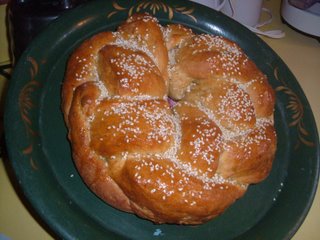 This year's Tsoureki
This year's TsourekiToday three of my grandaughters made Greek Easter bread with me. I made a big one, and they each made a small bread with 1/3 of the remaining dough to bring home. (They also made some amusing-looking "buns" out of leftover hot cross bun dough!) Here is the recipe: http://veganfeastkitchen.blogspot.ca/2006/04/easter-breads.html

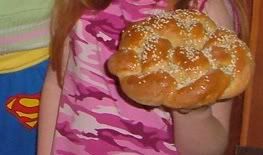
Have a wonderful Easter, everyone!

Labels:
Easter bread,
Greek,
Greek Easter bread,
tsoureki
Tuesday, April 11, 2006
EASTER BREADS

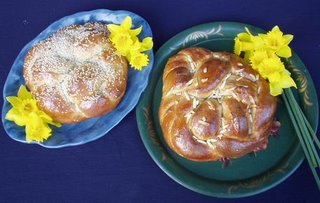
Greek Easter Breads: Sesame and Almond Tsoureki
FLASH: There are some absolutely beautiful origami-paper-covered Easter eggs which look quite easy to make on p. 85 of the April 2004 issue of Martha Stewart Living magazine. The instructions are available online here. **Vegans can cover ceramic or wooden "eggs", available at crafts stores, instead of blown-out real eggs.** UPDATE: Dye-able ceramic eggs, called Eggnots, are available here and here is the distributor in Canada. Paintable wooden eggs a readily available on Etsy.com.

This is a picture from Martha Stewart Living-- I didn't make these, BTW.
I have a thing about Easter breads. Easter doesn't seem like Easter without one. The yeast-risen breads are symbols of rebirth and the ring shapes of everlasting life. Eggs are also highly symbolic of rebirth. As vegans, we don't have to use real eggs-- we can use egg shapes in a symbolic way.
I used to make a special Italian Easter bread ring every year, because my father's Italian aunt, Tia Maria, made it every Easter in an outdoor oven in Lima, Peru. Of course, it contained eggs and butter, and was baked with raw, colored eggs nestled in the puffy dough (the eggs baked along with the bread).
I developed my own vegan version of this bread, but my oldest daughter, Bethany, still makes the one she grew up with, pictured here:

This is my vegan version, without eggs:
Printable Recipe:
BRYANNA'S PANE DI PASQUA (ITALIAN EASTER BREAD RING), GENOVESE-STYLE
(adapted from my book "Nonna's Italian Kitchen
© Bryanna Clark Grogan 2006
Because my father's maternal family came from the Genoa region of Italy, this Easter bread is flavored with orange flower water
This bread is traditionally made with colored raw eggs baked right in the twists of sweet dough. To stay vegan, but keep the ancient Spring Equinox/Easter egg-as-symbol-of-new-life-and-renewal theme, you can mound candy eggs in colored paper "straw" in the center of the ring (dairy-free, naturally-sweetened, organic chocolate eggs are available in many health food stores at Easter, or from amazon.com in vegan milk chocolate or vegan dark chocolate), or use polished colored decorative stone eggs
1/2 c. warm water
2 tsp. dry active baking yeast (or 1 1/2 tsp. instant yeast)
1/4 tsp. real Spanish saffron
1/2 c. nondairy milk
1/4 c. light organic unbleached sugar
3 T. vegan butter (try my palm-oil-free version)
grated zest of one orange (organic, if possible)
4 tsp. orange flower water (available in many Middle Eastern markets or gourmet stores)
2 tsp. vanilla
3/4 tsp. salt
1/2 tsp. fennel seeds, crushed
1/4 tsp. ground coriander
2 3/4 c. unbleached white flour
1/4 c. wheat germ
1/3 c. EACH golden raisins, dried currants, and chopped dried apricot
1/3 c. chopped lightly toasted pine nuts
Add the yeast and saffron to the warm water in a cup and let sit 5 or 10 minutes, until bubbly.
In a small saucepan or a microwave, heat the milk until it is just hot, with bubbles around the edges. Add the sugar and margarine and stir to dissolve. When the milk has cooled down a bit, add it to the yeast and water. Pour this into a large mixing bowl or the bowl of a heavy-duty mixer with a bread hook.
Add the orange zest(white only), orange flower water, vanilla, salt, crushed fennel, and ground coriander to the bowl. Stir in the wheat germ and 1 cup of the flour. Beat well for a minute or two, then gradually add the remaining flour.
Knead with a dough hook or by hand on a floured surface (adding as little flour as you can get away with-- oil your hands and the surface, if necessary) for 5-10 minutes.
FOOD PROCESSOR DOUGH:
You can make this dough in a food processor, following the directions given with your machine. DO NOT add the dried fruit and nuts to the machine-- knead them in by hand after the first rising as instructed in the recipe. Process the dough ("knead") for 30-60 seconds.
TO MAKE THE DOUGH IN A BREAD MACHINE:
Place the ingredients in the bread container in the order instructed for your machine. DO NOT add the dried fruit and nuts at the beginning. If your machine has a sweet bread cycle, it will beep when it's time to add these ingredients. Otherwise, you'll have to pay attention and add them toward the very end of the kneading cycle, so that they don't get pulverized. Let the bread go through the rising cycle.
WHICHEVER WAY YOU KNEADED IT:
Place the dough in a lightly-oiled bowl and turn it over to coat the top. Place the bowl in a large plastic bag or cover with a clean, damp tea towel and let rise in a warm place until doubled in size, 1 to 1 and 1/2 hours.
Turn the risen dough out on a lightly-floured surface and pat it out into a flat rectangle. Sprinkle the surface with the dried fruits and pine nuts. Roll up the dough jelly-roll style, then fold up the ends. Knead the dough gently by folding and rolling until the fruit, etc., are well-distributed throughout the dough.
Cut the risen dough in half. Roll each half on a lightly-floured board into a 24"-long "rope". Twist the two ropes of dough together loosely (starting in the middle) and form them into a ring on a lightly-greased baking sheet, tucking the ends together neatly and evenly. (See photos below.)
Meanwhile, preheat the oven to 350 degrees F. Bake the loaves for 30 minutes in the center or upper half of the oven, or just until they are a deep golden brown and sounds hollow when tapped on the bottom. Place on a rack to cool.
Spread either a powdered sugar glaze (organic powdered sugar is available), or the Protein-Sugar Glaze or White Maple Glaze (see recipes below) this on the bread while it's still warm and sprinkle the top with colored candy sprinkles, if you like.
BRYANNA’S WHITE MAPLE GLAZE Makes 1/2 c.
This can be used on sweet yeasted breads, tea breads, cupcakes, etc..
1/2 c. good-tasting powdered nondairy milk beverage (such as Better Than Milk soy or rice beverage mix or potato milk powder-- do not use bulk soymilk powder)
4 T. Grade A light maple syrup
1/4 tsp. vanilla or other flavor extract
Mix the ingredients together thoroughly in a bowl. For a thin glaze, spread it on the hot bread or cake. For a firmer glaze, spread it on the cooled bread or cake.
BRYANNA’S PROTEIN-SUGAR GLAZE Makes about 1/2 c.
For a sweeter glaze that gets a bit crusty, try this easy one. If you use unbleached sugar, it's more beige than white. It's good on baked doughnuts or muffins baked in miniature bundt pans .
1/2 c. light organic unbleached sugar
2 T. nondairy milk
2 T. rice protein powder or isolated soy protein powder
1/4 tsp. vanilla or other flavor extract
Melt the sugar and milk together in a small saucepan over medium heat, stirring, or MICROWAVE in a microwave-safe small bowl for 1 minute. Beat in the protein powder and vanilla with a hand blender or electric mixer. Spread on hot cake, etc..
ANOTHER OF MY FAVORITE EASTER BREADS IS GREEK TSOUREKI:
This lovely braided Easter bread is usually made with dyed red eggs baked into the indentations in the braid, but, for a vegan bread, you can surround the bread (after baking and cooling) with red egg-shaped candles or candies. (UPDATE: Now you can use red-dyed ceramic eggs baked into the bread. They are called Eggnots and there are links to info in the 1st paragraph of this post.)The eggs are an ancient religious symbol of fertility and rebirth, and red symbolizes Christ’s blood. Unfortunately, I didn’t have either at my disposal when I made my breads and took photos of them.
You can use the same dough as above and form it in the same way, but omit the orange zest, vanilla, fennel, coriander, dried fruit and pine nuts (you can use chopped almonds instead, if you wish), and, instead, use 1 tsp. of the Greek spice mahlepi described in the next paragraph, or use 3/4 tsp. ground anise seed. Instead of using a powdered sugar glaze (organic powdered sugar is available) or one of the glazes above, brush the cooled breads with this Sweet Glaze: Heat equal parts nondairy milk and maple syrup over medium heat. Do not boil or it may curdle. Brush over the breads to make a shiny glaze and sprinkle the loaves with lightly-toasted slivered almonds or sesame seeds.
Instead of the spices and dried fruits in the Italian bread, the Greek version is flavored with the Greek spice mahlepi,originally from Persia-- the hard small seed of a flowering tree like a cherry. It has a lovely spicy smell. You can find it in on amazon or in Greek and Middle Eastern grocery stores, but if you are unable to locate it, you can make a liquid substitute by simmering together over low heat for 20 minutes: 3 whole cloves, 1/2 a stick of cinnamon, 1 bay leaf and 3/4 c. water. Strain and use 2 T. for every 1 T. of mahlepi called for. (From" Cooking and Baking the Greek Way" by Anne Theoharous, Holt, Rinehart and Winston, New York, 1977.)
FORMING TSOUREKI OR PANE DI PASQUA:
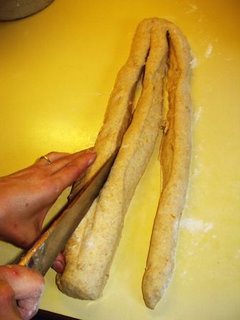

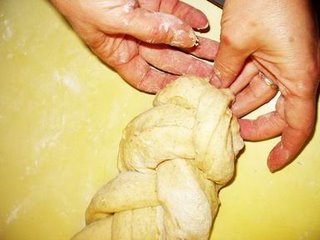


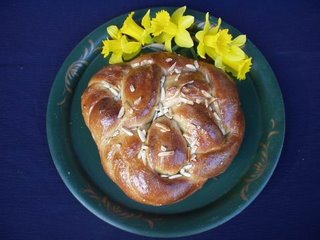

Subscribe to:
Posts (Atom)










